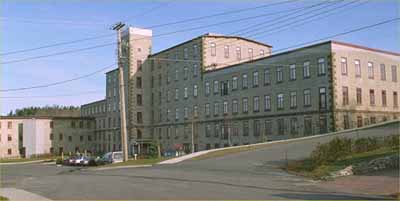Rosamond Woollen Mill National Historic Site of Canada
Almonte, Ontario

General view
(© Parks Canada Agency/Agence Parcs Canada, 1991.)
Address :
3 Rosamond Street East, Almonte, Ontario
Recognition Statute:
Historic Sites and Monuments Act (R.S.C., 1985, c. H-4)
Designation Date:
1986-06-16
Dates:
-
1866 to 1900
(Construction)
Event, Person, Organization:
Other Name(s):
-
Rosamond Woollen Mill
(Designation Name)
Research Report Number:
1986-SUC, 1989-SUB, 2005-116, 2005-SDC-121
Plaque(s)
Existing plaque: west of Mississippi Valley Textile Museum 3 Rosamond St. East, Almonte, Ontario
Between 1840 and 1870 woolen manufacturing emerged as a major Canadian industry. Mills were built in areas such as the Mississippi Valley, where waterpower, labour and wool supplies were abundant. James Rosamond built mills at the Carleton Place and Almonte in the 1840s and 1850s. His sons, Bennett and James, began this much larger mill in 1866, in partnership with George Stephen of Montréal. For the next 40 years it was one of the largest, most progressive mills in Canada. The main building's nearly flat roof, stair tower and fenestration are characteristic of late l9th century textile mills in Canada.
Description of Historic Place
The Rosamond Woollen Mill National Historic Site of Canada is located on Coleman Island next to the lower falls on the Mississippi River in the town of Almonte, Ontario. The mill’s main structure is a large, six-storey, flat-roofed, stone building that features a stair tower and regularly placed windows. It stands adjacent to a two-storey warehouse-and-office annex which survives from an original cluster of ancillary structures. In 1987 the process of converting the mill into residential condominiums was begun while the two-storey office and warehouse building was opened as the Mississippi Valley Textile Museum in 1991. Official recognition refers to the two buildings.
Heritage Value
The Rosamond Woollen Mill was designated a national historic site of Canada in 1986 because: it was one of the largest, most progressive mills in Canada; and the main building’s nearly flat roof, stair tower and fenestration are characteristic of late 19th-century textile mills in Canada.
Rosamond Woollen Mill was built in 1866 to manufacture fine tweeds. Milling emerged as a major manufacturing industry in Canada between 1840 and 1870. Mills were built in the Mississippi Valley, where waterpower, labour and wool supplies were abundant. James Rosamond built mills at Carleton Place and Almonte in the 1840s and 1850s. His sons, Bennett and James, began the large Almonte mill in 1866, in partnership with George Stephen of Montréal. Subsequent expansion of the mill continued until the early 1900s. The textile mill was a functioning industrial complex until 1986.
Source: Historic Sites and Monuments Board of Canada, Minutes, June 1986.
Character-Defining Elements
The key elements that contribute to the heritage character of this site include:
the prominent location on the bank of the Mississippi River in Almonte; the L-shaped massing of the large six-storey central block, and the two-storey, rectangular massing of the adjacent Annex building and warehouse; the quality of the construction materials used, notably limestone exterior walls; the characteristics common to late 19th-century textile mills in Canada that include the austere elevations, the nearly flat roof, the stair tower and the regular fenestration pattern; the remaining original interior configuration, features and finishes and the interior details of the Annex building offices including wood floors, wainscoting, trim, oak panelling, pressed metal ceilings, decorative use of stained glass, and legibility of the post and beam construction; the spatial relationship between the two remaining buildings and their relationship to the river.